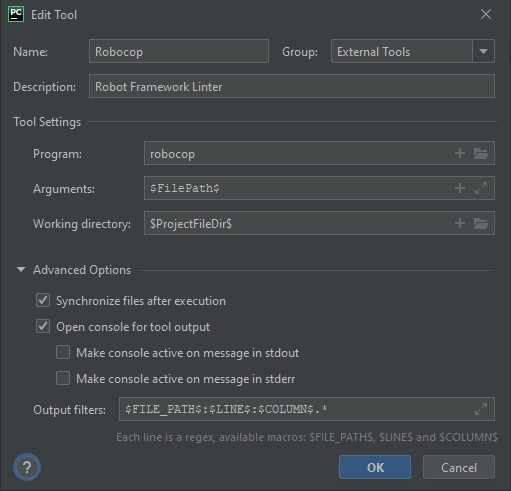Watch our talk from RoboCon 2021 about Robocop and Robotidy and learn more about these cool tools! 🤖
Robocop is a tool that performs static code analysis of Robot Framework code.
It uses official Robot Framework parsing API to parse files and run number of checks, looking for potential errors or violations to code quality standards.
Hosted on GitHub. 🎖️
Full documentation available here. 📖
Most common questions with answers can be found at the bottom ⬇ of this README file.
Original RoboCop - a fictional cybernetic police officer 👮♂️ - was following 3 prime directives which also drive the progress of Robocop linter:
First Directive: Serve the public trust 👨👩👧👦
Which lies behind the creation of the project - to serve developers and testers as a tool to build applications they can trust.
Second Directive: Protect the innocent 👶
The innocent testers and developers have no intention to produce ugly code but sometimes, you know, it just happens, so Robocop is there to protect them.
Third Directive: Uphold the law 🏛️
Following the coding guidelines established in the project are something very important to keep the code clean, readable and understandable by others and Robocop can help to uphold the law.
Python 3.6+ 🐍 and Robot Framework 3.2.2+ 🤖.
You can install Robocop simply by running::
pip install robotframework-robocop
Robocop runs by default from the current directory and it discovers supported files recursively. You can simply run::
robocop
All command line options can be displayed in help message by executing::
robocop -h
Executing command::
robocop --report rules_by_error_type tests\test.robot
Will result in following output::
C:\OCP_project\tests\test.robot:7:0 [W] 0509 Section is empty (empty-section)
C:\OCP_project\tests\test.robot:22:0 [E] 0801 Multiple test cases with name "Simple Test" in suite (duplicated-test-case)
C:\OCP_project\tests\test.robot:42:0 [E] 0810 Both Task(s) and Test Case(s) section headers defined in file (both-tests-and-tasks)
C:\OCP_project\tests\test.robot:48:0 [W] 0302 Keyword name should be capitalized (not-capitalized-keyword-name)
C:\OCP_project\tests\test.robot:51:13 [I] 0606 This tag is already set by Force Tags in suite settings (tag-already-set-in-force-tags)
Found 5 issue(s): 2 WARNING(s), 2 ERROR(s), 1 INFO(s).Can I integrate Robocop with my code editor (IDE)?
Yes, Robocop integrates nicely with popular IDEs like PyCharm or VSCode thanks to Robot Framework Language Server. Read simple manual (README) in that project to figure out how to install & use it.
You can also use Robocop in PyCharm easily as an external tool.
To configure it, go to: File → Settings → Tools → External Tools
and click + icon. Then put values based on
official instructions
or this screenshot:
If you're using Python virtual environment in your project,
make sure to provide correct path to robocop.exe located in venv\Scripts\robocop.exe.
Now, you can run Robocop by right-clicking on a file or directory and choosing
External tools → Robocop.
We suggest also to add a keyboard shortcut (e.g. Ctrl + , (comma))
to quickly run Robocop on selected files. You can map the shortcut in Settings → Keymap.
Can I load configuration from file?
Yes, there are multiple ways to configure Robocop:
You can add command line options to an argument file, preferably one option with value for a line.
Such file can be used as an input for Robocop with --argumentfile / -A option, e.g.
robocop -A robocop.cfg. You can mix arguments from a file with ones provided in run command.
Example argument file:
--exclude *doc*
--exclude 0510
--threshold W
--configure inconsistent-assignment:assignment_sign_type:equal_sign
--configure line-too-long:line_length:140
--reports all
--output robocop.log
It is a default file that is loaded only when no command line options are provided for Robocop.
When running plain robocop command, it looks for .robocop file from place where it was run
until it finds .git file. Options can be provided like in the example above.
If there is no .robocop file and toml module is installed,
Robocop will try to load configuration from pyproject.toml file (if it exists).
Options have the same names as command line arguments
and need to be placed under [tool.robocop] section.
Example configuration file:
[tool.robocop]
paths = [
"tests\\atest\\rules\\bad-indent",
"tests\\atest\\rules\\duplicated-library"
]
include = ['W0504', '*doc*']
exclude = ["0203"]
reports = [
"rules_by_id",
"scan_timer"
]
ignore = ["ignore_me.robot"]
ext-rules = ["path_to_external\\dir"]
filetypes = [".txt", ".csv"]
threshold = "E"
format = "{source}:{line}:{col} [{severity}] {rule_id} {desc} (name)"
output = "robocop.log"
configure = [
"line-too-long:line_length:150",
"0201:severity:E"
]
no_recursive = true
I use different coding standards. Can I configure rules so that they fit my needs?
Yes, some rules are configurable. You can list them by running robocop --list-configurables
or just robocop -lc.
Configuring is done by using -c / --configure command line option followed by pattern
<rule>:<param_name>:<value> where:
<rule>can either be rule name or its id<param_name>is a public name of the parameter<value>is a desired value of the parameter
For example:
--configure line-too-long:line_length:140
is equivalent to
-c 0508:line_length:140
Each rule's severity can also be overwritten. Possible values are
e/error, w/warning or i/info and are case-insensitive. Example:
-c too-long-test-case:severity:e
If there are special cases in your code that violate the rules, you can also exclude them in the source code.
Example:
Keyword with lowercased name # robocop: disable
More about it in our documentation.
Can I define custom rules?
Yes, you can define and include custom rules using -rules / --ext-rules command line option
by providing a path to a file containing your rule(s). The option accepts comma-separated list
of paths to files or directories, e.g.
robocop -rules my/own/rule.py --ext-rules rules.py,external_rules.py
If you feel that your rule is very helpful and should be included in Robocop permanently, you can always share your solution by submitting a pull request. You can also share your idea by creating an issue.
More about external rules with code examples in our documentation.
Can I use Robocop in continuous integration (CI) tools?
Yes, it is easy to integrate Robocop with other tools.
It is possible to redirect the output to a file by using -o / --output command line option
which can later be easily parsed because the format is very similar to other linter tools like
pylint.
For example in Jenkins you can use Warnings Next Generation plugin to integrate Robocop results in your pipeline. More details can be found here.
One of the important topics related to CI is return code which can also be configured in Robocop. More on that can be found in the next question or in our documentation.
Can I configure return status / code?
Yes, by default Robocop returns code 0 if number of found issues does not exceed quality gates.
Quality gates are the number specified for each severity (error, warning, info) that cannot be exceeded. Every violation of quality gates increases the return code by 1 up to maximum of 255. Default values for quality gates are:
quality_gate = {
'E': 0,
'W': 0,
'I': -1
}
which shows the accepted number of issues by severity. In that case each error and warning increases the return code. Rules with INFO severity do not affect the return code.
To configure quality gates, you simply use -c / --configure command line option
with following pattern --configure return_status:quality_gates:<severity>=limit.
You can change all limits at once. Example:
--configure return_status:quality_gates:E=0:W=100:I=-1
which means that no errors are accepted, up to 100 warnings are tolerated and issues with INFO severity do not affect the return code.
What is the difference between Robocop and rflint?
Robocop is better in every case because it:
- has maaaaany rules that check the quality of your Robot Framework code
- is integrated with popular IDE tools
- is highly configurable
- has very good defaults that work out of the box
- can be configured in source code
- uses latest Robot Framework Parsing API
- is actively developed & fixed
- is easy to integrate with external tools
- can redirect output to a file
- displays nice reports
- is easy to extend it with new rules
- is cool 🤓
Still not convinced? Watch our talk about Robocop & Robotidy and see for yourself! 🧐
Excuse me, I have to go. Somewhere there is a crime happening. - Robocop







